NEM3201 Manufacturing Materials Laboratory 2: Heat Treatment of AA6061
VerifiedAdded on 2022/11/29
|11
|2112
|422
Practical Assignment
AI Summary
This laboratory report details an investigation into the heat treatment of AA6061 aluminum alloy, a common material in manufacturing. The objective was to analyze the effects of heat treatment on the alloy's mechanical properties, particularly its hardness. The experiment involved heating samples to 530°C, followed by quenching in water and oil, and then subjecting them to Rockwell B hardness testing. The results, including time variations and hardness measurements, were meticulously recorded and analyzed. The report discusses the influence of heat treatment parameters on the alloy's hardness, comparing the results with theoretical expectations and accounting for potential sources of error. The findings indicate that the alloy's hardness increased after quenching, with water providing a higher cooling rate than oil. The study concludes that careful selection of cooling media and heat treatment procedures is crucial for achieving desired mechanical properties in AA6061 aluminum alloy. The report includes experimental methods, results, discussions, and a conclusion summarizing the key findings.
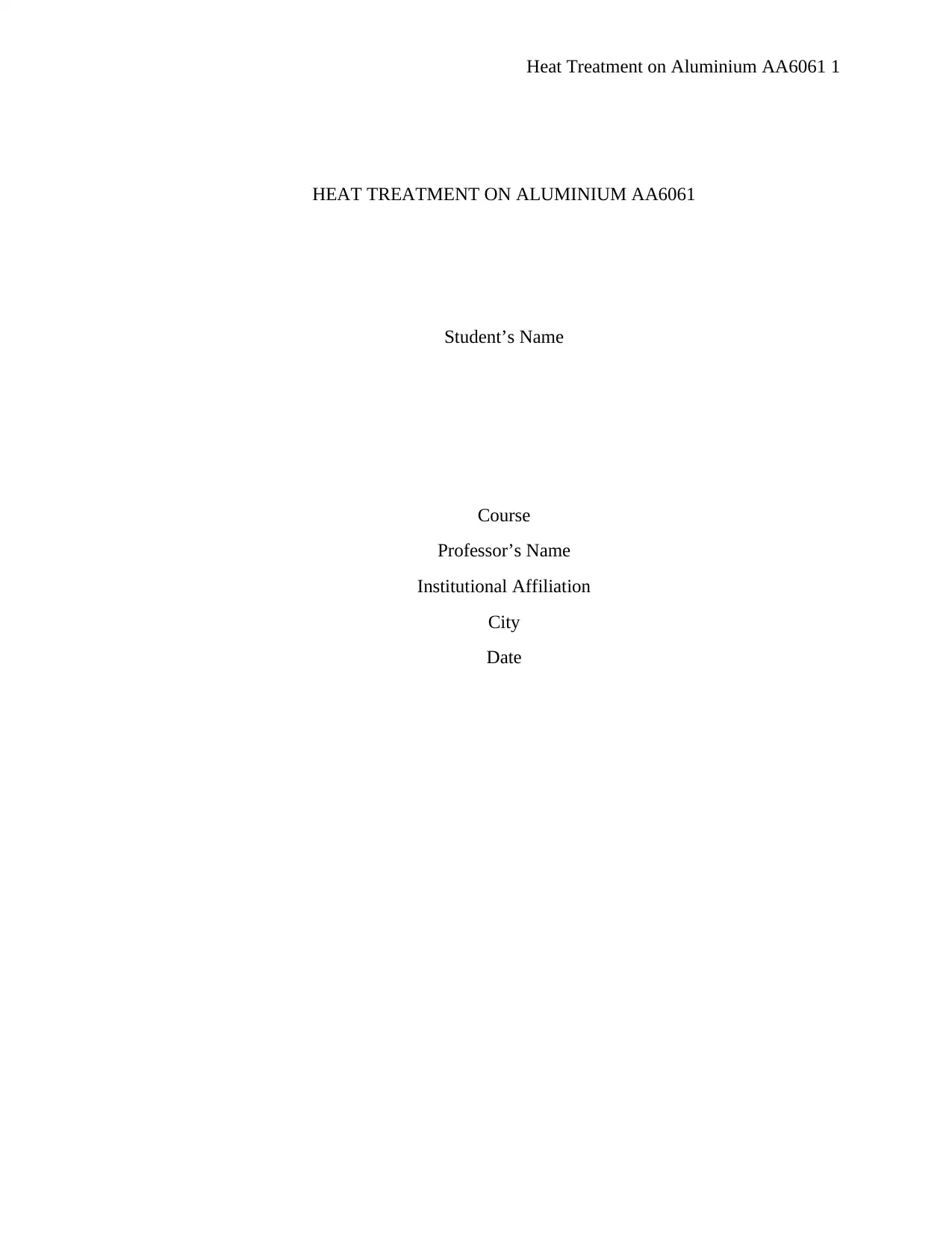
Heat Treatment on Aluminium AA6061 1
HEAT TREATMENT ON ALUMINIUM AA6061
Student’s Name
Course
Professor’s Name
Institutional Affiliation
City
Date
HEAT TREATMENT ON ALUMINIUM AA6061
Student’s Name
Course
Professor’s Name
Institutional Affiliation
City
Date
Paraphrase This Document
Need a fresh take? Get an instant paraphrase of this document with our AI Paraphraser
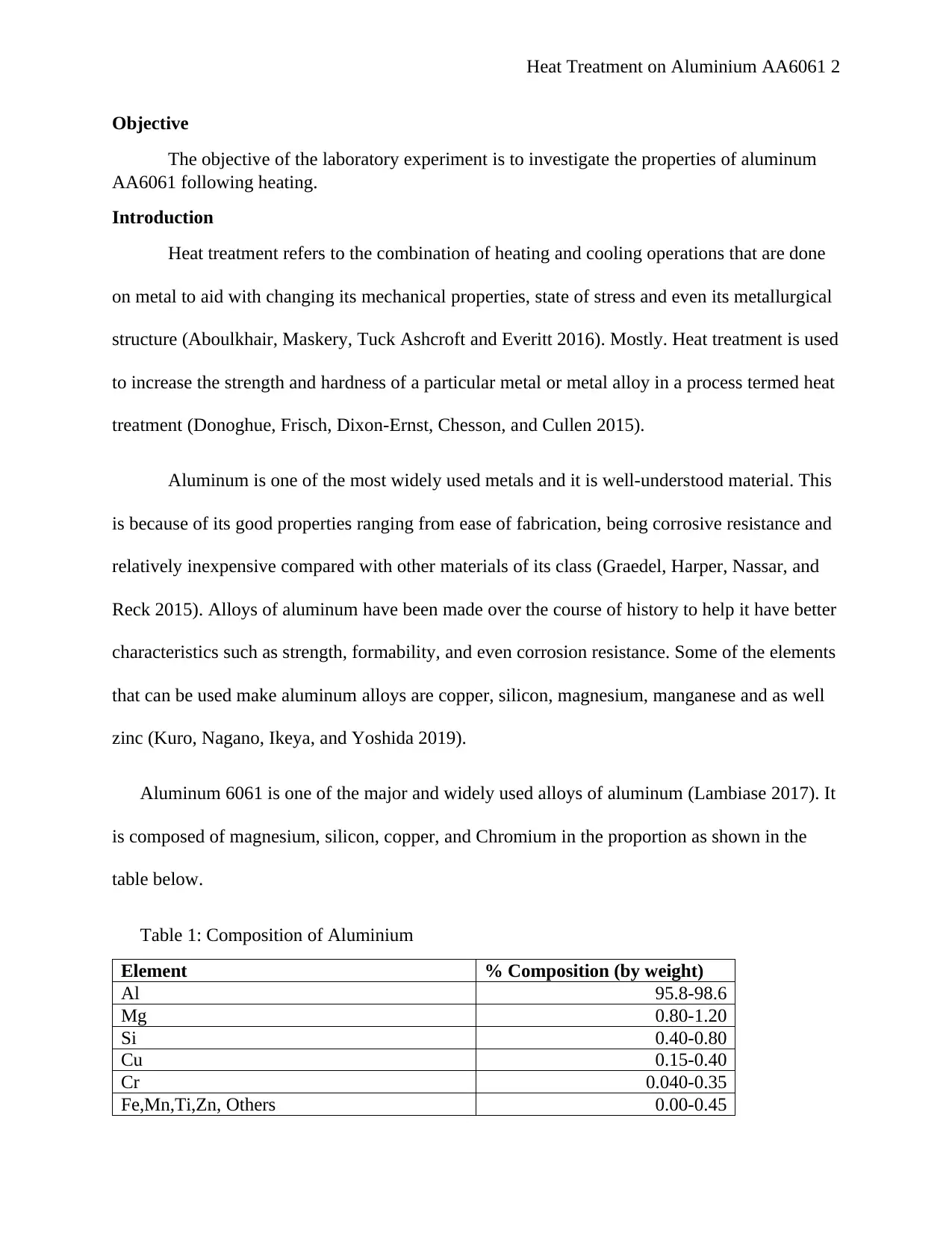
Heat Treatment on Aluminium AA6061 2
Objective
The objective of the laboratory experiment is to investigate the properties of aluminum
AA6061 following heating.
Introduction
Heat treatment refers to the combination of heating and cooling operations that are done
on metal to aid with changing its mechanical properties, state of stress and even its metallurgical
structure (Aboulkhair, Maskery, Tuck Ashcroft and Everitt 2016). Mostly. Heat treatment is used
to increase the strength and hardness of a particular metal or metal alloy in a process termed heat
treatment (Donoghue, Frisch, Dixon-Ernst, Chesson, and Cullen 2015).
Aluminum is one of the most widely used metals and it is well-understood material. This
is because of its good properties ranging from ease of fabrication, being corrosive resistance and
relatively inexpensive compared with other materials of its class (Graedel, Harper, Nassar, and
Reck 2015). Alloys of aluminum have been made over the course of history to help it have better
characteristics such as strength, formability, and even corrosion resistance. Some of the elements
that can be used make aluminum alloys are copper, silicon, magnesium, manganese and as well
zinc (Kuro, Nagano, Ikeya, and Yoshida 2019).
Aluminum 6061 is one of the major and widely used alloys of aluminum (Lambiase 2017). It
is composed of magnesium, silicon, copper, and Chromium in the proportion as shown in the
table below.
Table 1: Composition of Aluminium
Element % Composition (by weight)
Al 95.8-98.6
Mg 0.80-1.20
Si 0.40-0.80
Cu 0.15-0.40
Cr 0.040-0.35
Fe,Mn,Ti,Zn, Others 0.00-0.45
Objective
The objective of the laboratory experiment is to investigate the properties of aluminum
AA6061 following heating.
Introduction
Heat treatment refers to the combination of heating and cooling operations that are done
on metal to aid with changing its mechanical properties, state of stress and even its metallurgical
structure (Aboulkhair, Maskery, Tuck Ashcroft and Everitt 2016). Mostly. Heat treatment is used
to increase the strength and hardness of a particular metal or metal alloy in a process termed heat
treatment (Donoghue, Frisch, Dixon-Ernst, Chesson, and Cullen 2015).
Aluminum is one of the most widely used metals and it is well-understood material. This
is because of its good properties ranging from ease of fabrication, being corrosive resistance and
relatively inexpensive compared with other materials of its class (Graedel, Harper, Nassar, and
Reck 2015). Alloys of aluminum have been made over the course of history to help it have better
characteristics such as strength, formability, and even corrosion resistance. Some of the elements
that can be used make aluminum alloys are copper, silicon, magnesium, manganese and as well
zinc (Kuro, Nagano, Ikeya, and Yoshida 2019).
Aluminum 6061 is one of the major and widely used alloys of aluminum (Lambiase 2017). It
is composed of magnesium, silicon, copper, and Chromium in the proportion as shown in the
table below.
Table 1: Composition of Aluminium
Element % Composition (by weight)
Al 95.8-98.6
Mg 0.80-1.20
Si 0.40-0.80
Cu 0.15-0.40
Cr 0.040-0.35
Fe,Mn,Ti,Zn, Others 0.00-0.45
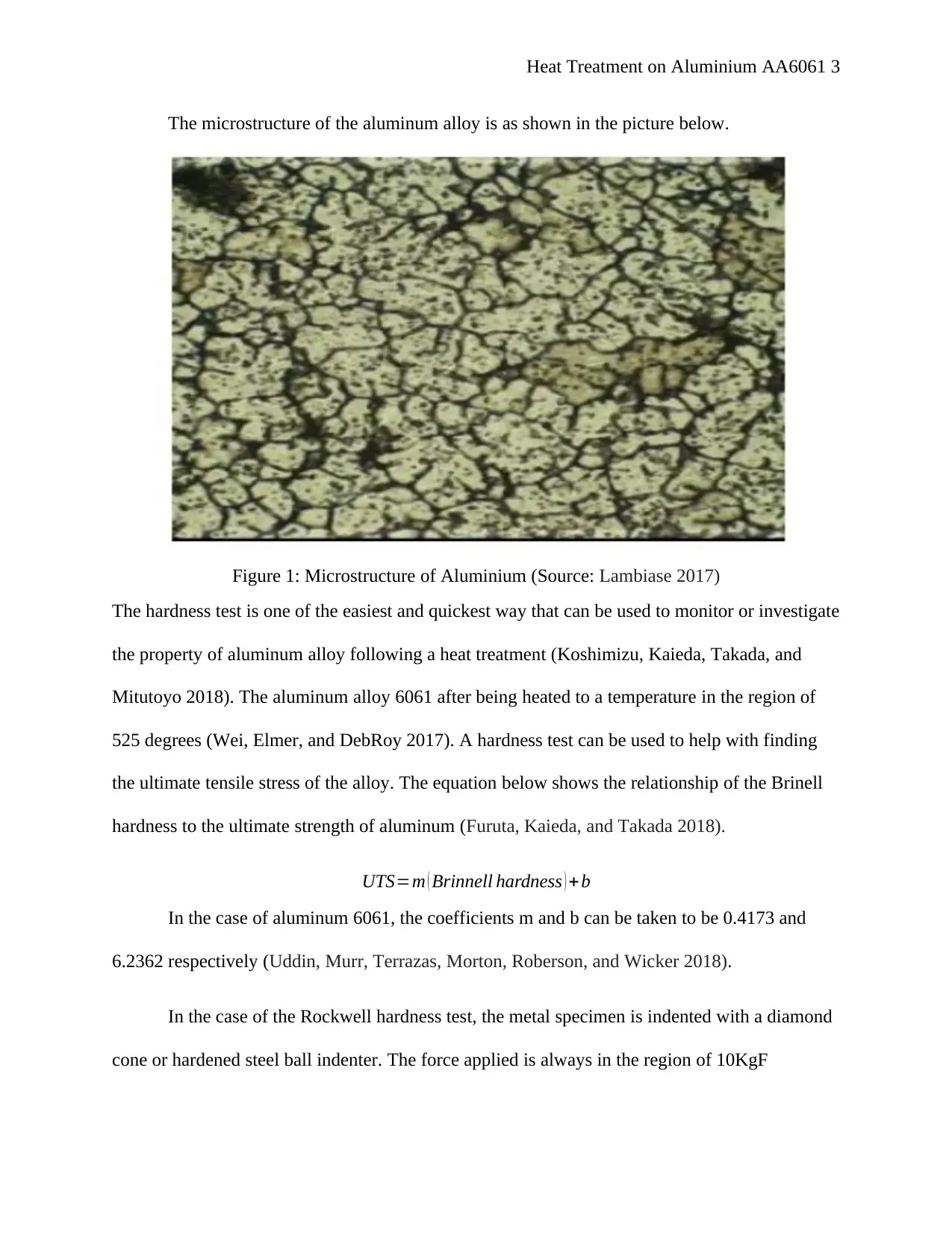
Heat Treatment on Aluminium AA6061 3
The microstructure of the aluminum alloy is as shown in the picture below.
Figure 1: Microstructure of Aluminium (Source: Lambiase 2017)
The hardness test is one of the easiest and quickest way that can be used to monitor or investigate
the property of aluminum alloy following a heat treatment (Koshimizu, Kaieda, Takada, and
Mitutoyo 2018). The aluminum alloy 6061 after being heated to a temperature in the region of
525 degrees (Wei, Elmer, and DebRoy 2017). A hardness test can be used to help with finding
the ultimate tensile stress of the alloy. The equation below shows the relationship of the Brinell
hardness to the ultimate strength of aluminum (Furuta, Kaieda, and Takada 2018).
UTS=m ( Brinnell hardness ) +b
In the case of aluminum 6061, the coefficients m and b can be taken to be 0.4173 and
6.2362 respectively (Uddin, Murr, Terrazas, Morton, Roberson, and Wicker 2018).
In the case of the Rockwell hardness test, the metal specimen is indented with a diamond
cone or hardened steel ball indenter. The force applied is always in the region of 10KgF
The microstructure of the aluminum alloy is as shown in the picture below.
Figure 1: Microstructure of Aluminium (Source: Lambiase 2017)
The hardness test is one of the easiest and quickest way that can be used to monitor or investigate
the property of aluminum alloy following a heat treatment (Koshimizu, Kaieda, Takada, and
Mitutoyo 2018). The aluminum alloy 6061 after being heated to a temperature in the region of
525 degrees (Wei, Elmer, and DebRoy 2017). A hardness test can be used to help with finding
the ultimate tensile stress of the alloy. The equation below shows the relationship of the Brinell
hardness to the ultimate strength of aluminum (Furuta, Kaieda, and Takada 2018).
UTS=m ( Brinnell hardness ) +b
In the case of aluminum 6061, the coefficients m and b can be taken to be 0.4173 and
6.2362 respectively (Uddin, Murr, Terrazas, Morton, Roberson, and Wicker 2018).
In the case of the Rockwell hardness test, the metal specimen is indented with a diamond
cone or hardened steel ball indenter. The force applied is always in the region of 10KgF
⊘ This is a preview!⊘
Do you want full access?
Subscribe today to unlock all pages.

Trusted by 1+ million students worldwide
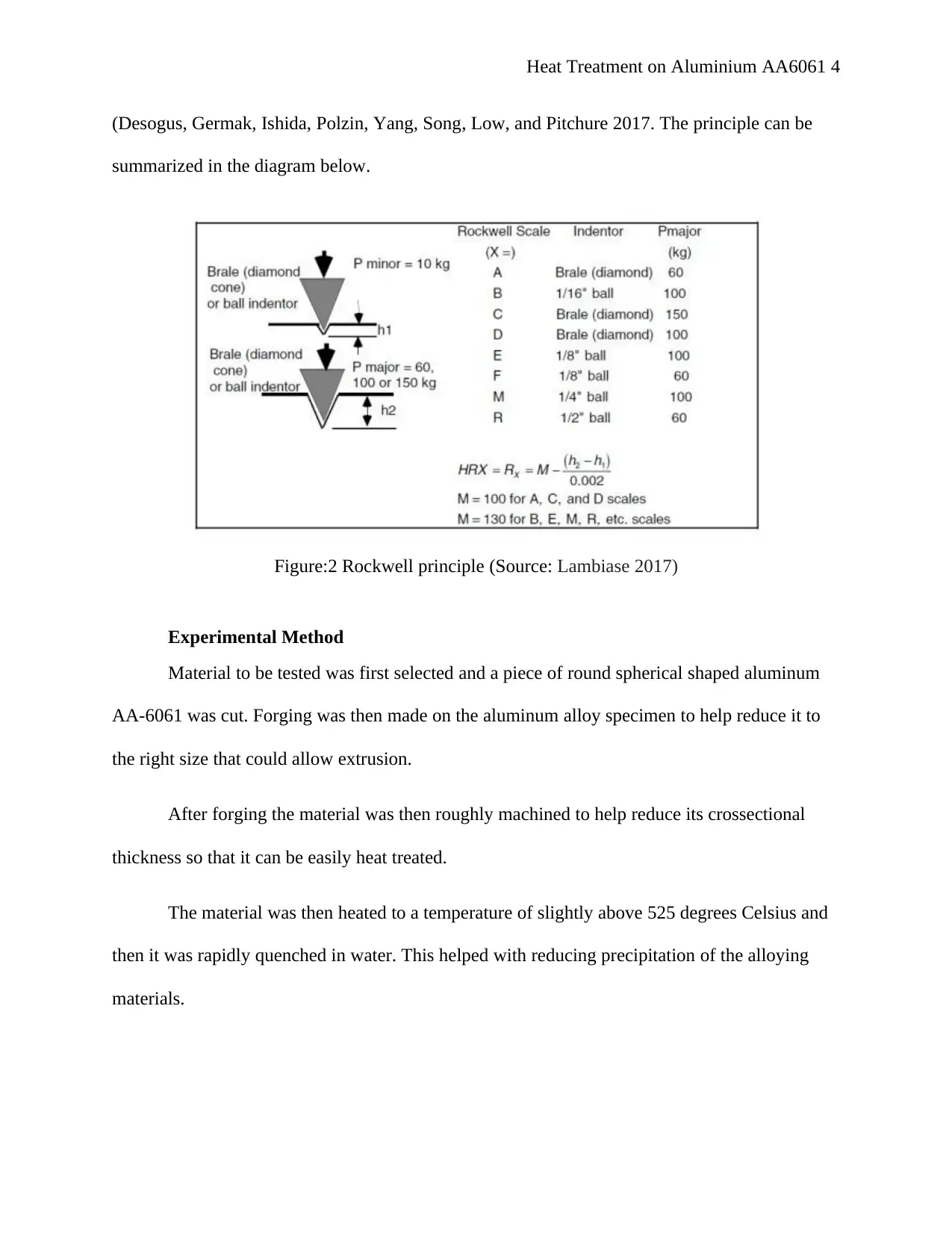
Heat Treatment on Aluminium AA6061 4
(Desogus, Germak, Ishida, Polzin, Yang, Song, Low, and Pitchure 2017. The principle can be
summarized in the diagram below.
Figure:2 Rockwell principle (Source: Lambiase 2017)
Experimental Method
Material to be tested was first selected and a piece of round spherical shaped aluminum
AA-6061 was cut. Forging was then made on the aluminum alloy specimen to help reduce it to
the right size that could allow extrusion.
After forging the material was then roughly machined to help reduce its crossectional
thickness so that it can be easily heat treated.
The material was then heated to a temperature of slightly above 525 degrees Celsius and
then it was rapidly quenched in water. This helped with reducing precipitation of the alloying
materials.
(Desogus, Germak, Ishida, Polzin, Yang, Song, Low, and Pitchure 2017. The principle can be
summarized in the diagram below.
Figure:2 Rockwell principle (Source: Lambiase 2017)
Experimental Method
Material to be tested was first selected and a piece of round spherical shaped aluminum
AA-6061 was cut. Forging was then made on the aluminum alloy specimen to help reduce it to
the right size that could allow extrusion.
After forging the material was then roughly machined to help reduce its crossectional
thickness so that it can be easily heat treated.
The material was then heated to a temperature of slightly above 525 degrees Celsius and
then it was rapidly quenched in water. This helped with reducing precipitation of the alloying
materials.
Paraphrase This Document
Need a fresh take? Get an instant paraphrase of this document with our AI Paraphraser
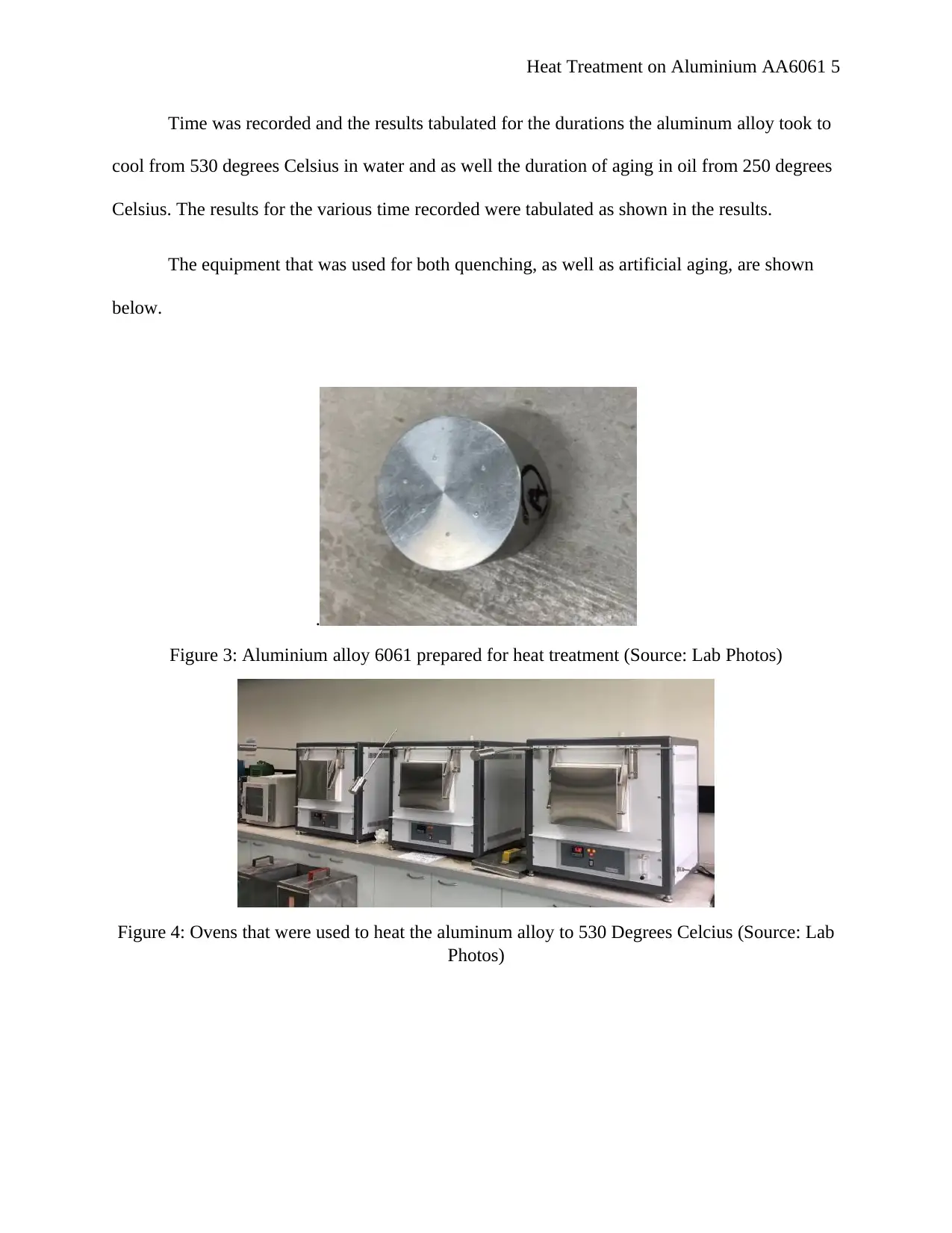
Heat Treatment on Aluminium AA6061 5
Time was recorded and the results tabulated for the durations the aluminum alloy took to
cool from 530 degrees Celsius in water and as well the duration of aging in oil from 250 degrees
Celsius. The results for the various time recorded were tabulated as shown in the results.
The equipment that was used for both quenching, as well as artificial aging, are shown
below.
.
Figure 3: Aluminium alloy 6061 prepared for heat treatment (Source: Lab Photos)
Figure 4: Ovens that were used to heat the aluminum alloy to 530 Degrees Celcius (Source: Lab
Photos)
Time was recorded and the results tabulated for the durations the aluminum alloy took to
cool from 530 degrees Celsius in water and as well the duration of aging in oil from 250 degrees
Celsius. The results for the various time recorded were tabulated as shown in the results.
The equipment that was used for both quenching, as well as artificial aging, are shown
below.
.
Figure 3: Aluminium alloy 6061 prepared for heat treatment (Source: Lab Photos)
Figure 4: Ovens that were used to heat the aluminum alloy to 530 Degrees Celcius (Source: Lab
Photos)
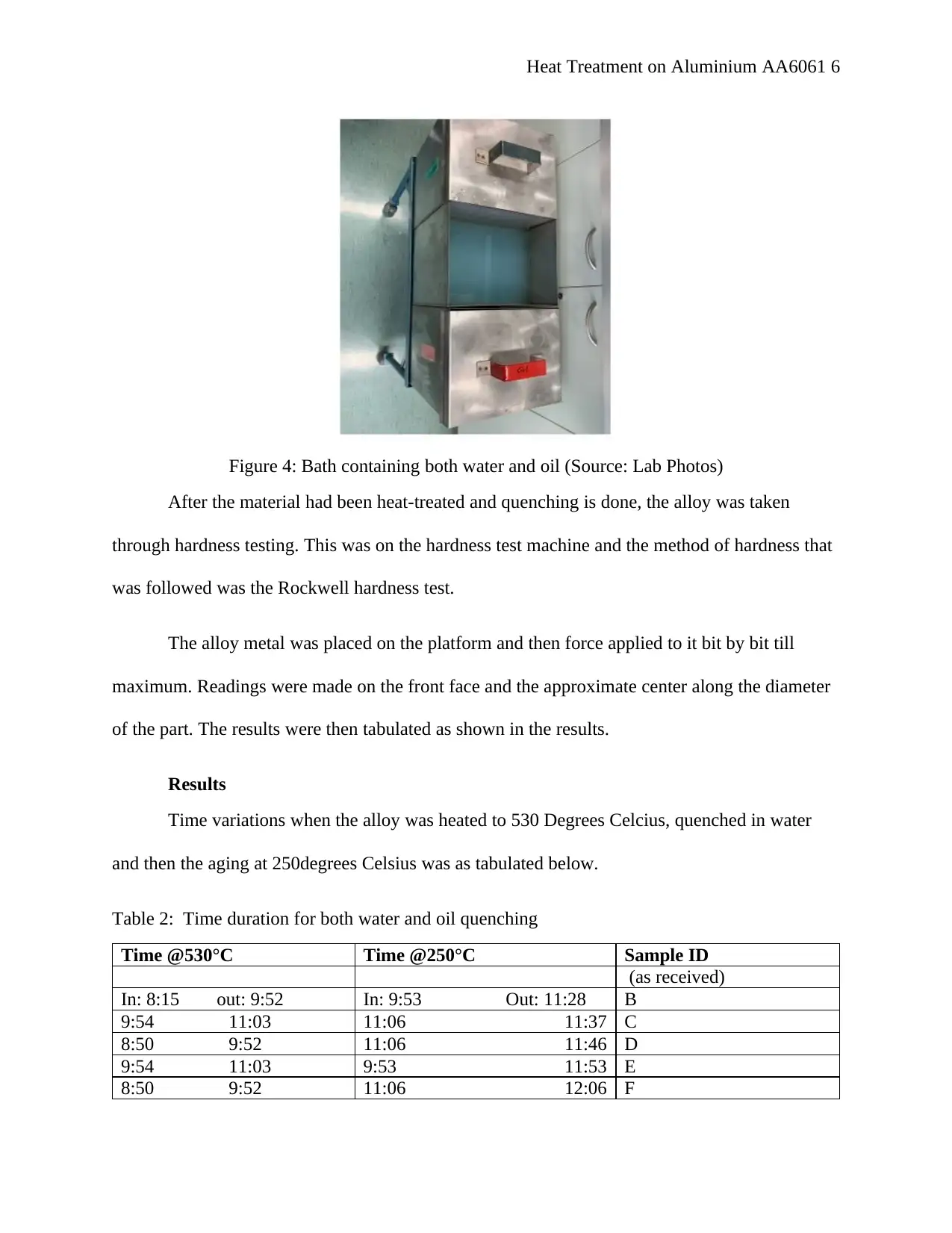
Heat Treatment on Aluminium AA6061 6
Figure 4: Bath containing both water and oil (Source: Lab Photos)
After the material had been heat-treated and quenching is done, the alloy was taken
through hardness testing. This was on the hardness test machine and the method of hardness that
was followed was the Rockwell hardness test.
The alloy metal was placed on the platform and then force applied to it bit by bit till
maximum. Readings were made on the front face and the approximate center along the diameter
of the part. The results were then tabulated as shown in the results.
Results
Time variations when the alloy was heated to 530 Degrees Celcius, quenched in water
and then the aging at 250degrees Celsius was as tabulated below.
Table 2: Time duration for both water and oil quenching
Time @530°C Time @250°C Sample ID
(as received)
In: 8:15 out: 9:52 In: 9:53 Out: 11:28 B
9:54 11:03 11:06 11:37 C
8:50 9:52 11:06 11:46 D
9:54 11:03 9:53 11:53 E
8:50 9:52 11:06 12:06 F
Figure 4: Bath containing both water and oil (Source: Lab Photos)
After the material had been heat-treated and quenching is done, the alloy was taken
through hardness testing. This was on the hardness test machine and the method of hardness that
was followed was the Rockwell hardness test.
The alloy metal was placed on the platform and then force applied to it bit by bit till
maximum. Readings were made on the front face and the approximate center along the diameter
of the part. The results were then tabulated as shown in the results.
Results
Time variations when the alloy was heated to 530 Degrees Celcius, quenched in water
and then the aging at 250degrees Celsius was as tabulated below.
Table 2: Time duration for both water and oil quenching
Time @530°C Time @250°C Sample ID
(as received)
In: 8:15 out: 9:52 In: 9:53 Out: 11:28 B
9:54 11:03 11:06 11:37 C
8:50 9:52 11:06 11:46 D
9:54 11:03 9:53 11:53 E
8:50 9:52 11:06 12:06 F
⊘ This is a preview!⊘
Do you want full access?
Subscribe today to unlock all pages.

Trusted by 1+ million students worldwide
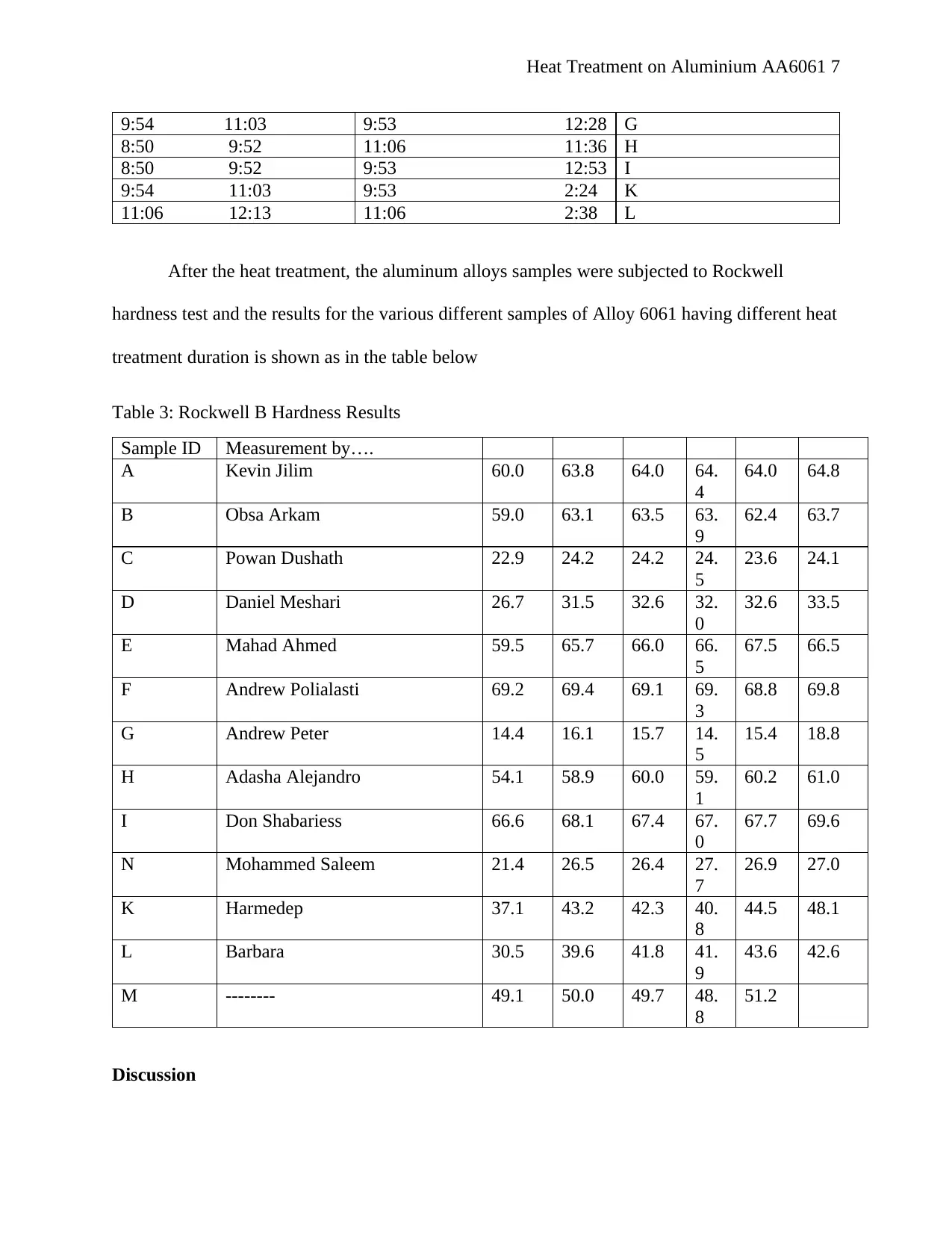
Heat Treatment on Aluminium AA6061 7
9:54 11:03 9:53 12:28 G
8:50 9:52 11:06 11:36 H
8:50 9:52 9:53 12:53 I
9:54 11:03 9:53 2:24 K
11:06 12:13 11:06 2:38 L
After the heat treatment, the aluminum alloys samples were subjected to Rockwell
hardness test and the results for the various different samples of Alloy 6061 having different heat
treatment duration is shown as in the table below
Table 3: Rockwell B Hardness Results
Sample ID Measurement by….
A Kevin Jilim 60.0 63.8 64.0 64.
4
64.0 64.8
B Obsa Arkam 59.0 63.1 63.5 63.
9
62.4 63.7
C Powan Dushath 22.9 24.2 24.2 24.
5
23.6 24.1
D Daniel Meshari 26.7 31.5 32.6 32.
0
32.6 33.5
E Mahad Ahmed 59.5 65.7 66.0 66.
5
67.5 66.5
F Andrew Polialasti 69.2 69.4 69.1 69.
3
68.8 69.8
G Andrew Peter 14.4 16.1 15.7 14.
5
15.4 18.8
H Adasha Alejandro 54.1 58.9 60.0 59.
1
60.2 61.0
I Don Shabariess 66.6 68.1 67.4 67.
0
67.7 69.6
N Mohammed Saleem 21.4 26.5 26.4 27.
7
26.9 27.0
K Harmedep 37.1 43.2 42.3 40.
8
44.5 48.1
L Barbara 30.5 39.6 41.8 41.
9
43.6 42.6
M -------- 49.1 50.0 49.7 48.
8
51.2
Discussion
9:54 11:03 9:53 12:28 G
8:50 9:52 11:06 11:36 H
8:50 9:52 9:53 12:53 I
9:54 11:03 9:53 2:24 K
11:06 12:13 11:06 2:38 L
After the heat treatment, the aluminum alloys samples were subjected to Rockwell
hardness test and the results for the various different samples of Alloy 6061 having different heat
treatment duration is shown as in the table below
Table 3: Rockwell B Hardness Results
Sample ID Measurement by….
A Kevin Jilim 60.0 63.8 64.0 64.
4
64.0 64.8
B Obsa Arkam 59.0 63.1 63.5 63.
9
62.4 63.7
C Powan Dushath 22.9 24.2 24.2 24.
5
23.6 24.1
D Daniel Meshari 26.7 31.5 32.6 32.
0
32.6 33.5
E Mahad Ahmed 59.5 65.7 66.0 66.
5
67.5 66.5
F Andrew Polialasti 69.2 69.4 69.1 69.
3
68.8 69.8
G Andrew Peter 14.4 16.1 15.7 14.
5
15.4 18.8
H Adasha Alejandro 54.1 58.9 60.0 59.
1
60.2 61.0
I Don Shabariess 66.6 68.1 67.4 67.
0
67.7 69.6
N Mohammed Saleem 21.4 26.5 26.4 27.
7
26.9 27.0
K Harmedep 37.1 43.2 42.3 40.
8
44.5 48.1
L Barbara 30.5 39.6 41.8 41.
9
43.6 42.6
M -------- 49.1 50.0 49.7 48.
8
51.2
Discussion
Paraphrase This Document
Need a fresh take? Get an instant paraphrase of this document with our AI Paraphraser
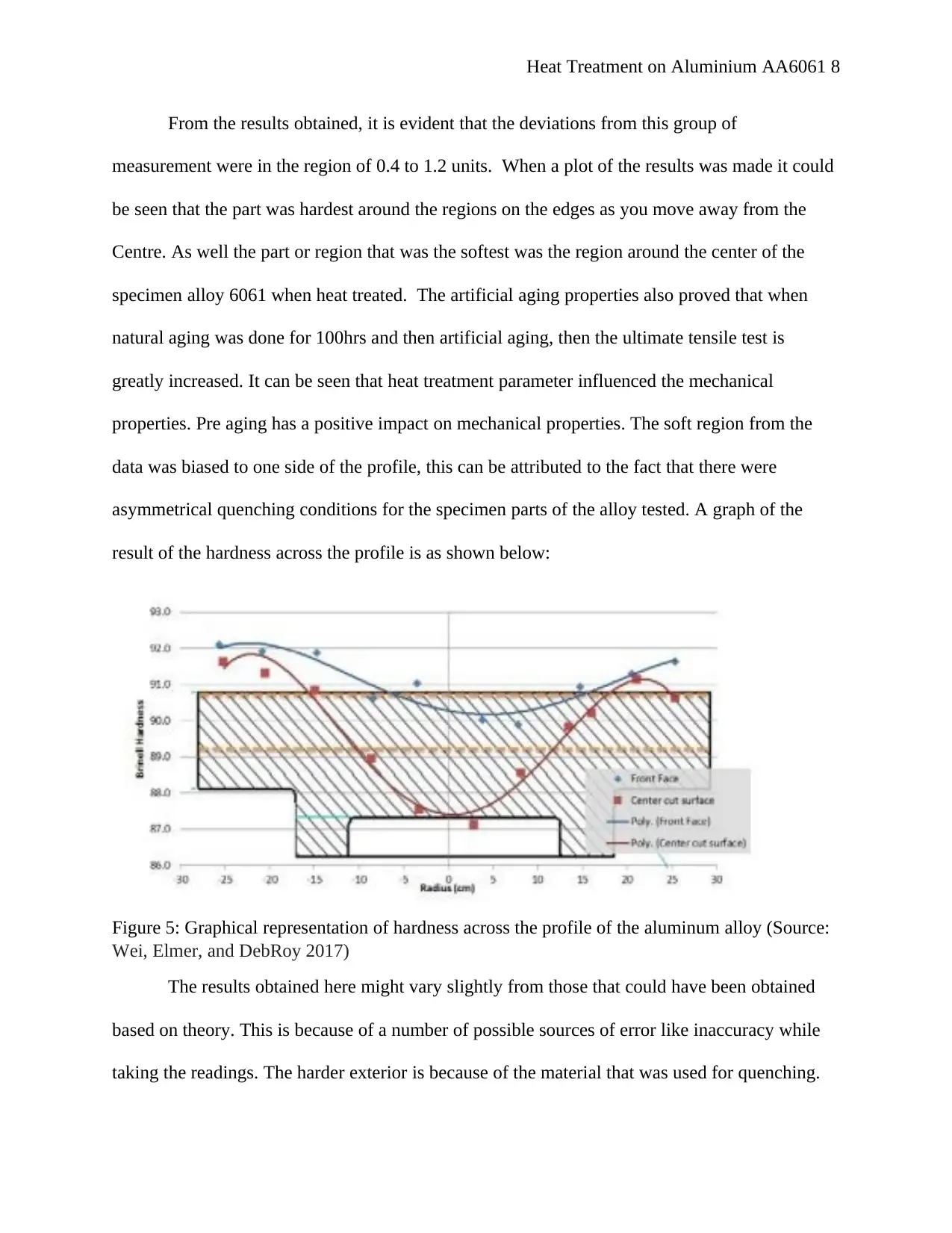
Heat Treatment on Aluminium AA6061 8
From the results obtained, it is evident that the deviations from this group of
measurement were in the region of 0.4 to 1.2 units. When a plot of the results was made it could
be seen that the part was hardest around the regions on the edges as you move away from the
Centre. As well the part or region that was the softest was the region around the center of the
specimen alloy 6061 when heat treated. The artificial aging properties also proved that when
natural aging was done for 100hrs and then artificial aging, then the ultimate tensile test is
greatly increased. It can be seen that heat treatment parameter influenced the mechanical
properties. Pre aging has a positive impact on mechanical properties. The soft region from the
data was biased to one side of the profile, this can be attributed to the fact that there were
asymmetrical quenching conditions for the specimen parts of the alloy tested. A graph of the
result of the hardness across the profile is as shown below:
Figure 5: Graphical representation of hardness across the profile of the aluminum alloy (Source:
Wei, Elmer, and DebRoy 2017)
The results obtained here might vary slightly from those that could have been obtained
based on theory. This is because of a number of possible sources of error like inaccuracy while
taking the readings. The harder exterior is because of the material that was used for quenching.
From the results obtained, it is evident that the deviations from this group of
measurement were in the region of 0.4 to 1.2 units. When a plot of the results was made it could
be seen that the part was hardest around the regions on the edges as you move away from the
Centre. As well the part or region that was the softest was the region around the center of the
specimen alloy 6061 when heat treated. The artificial aging properties also proved that when
natural aging was done for 100hrs and then artificial aging, then the ultimate tensile test is
greatly increased. It can be seen that heat treatment parameter influenced the mechanical
properties. Pre aging has a positive impact on mechanical properties. The soft region from the
data was biased to one side of the profile, this can be attributed to the fact that there were
asymmetrical quenching conditions for the specimen parts of the alloy tested. A graph of the
result of the hardness across the profile is as shown below:
Figure 5: Graphical representation of hardness across the profile of the aluminum alloy (Source:
Wei, Elmer, and DebRoy 2017)
The results obtained here might vary slightly from those that could have been obtained
based on theory. This is because of a number of possible sources of error like inaccuracy while
taking the readings. The harder exterior is because of the material that was used for quenching.
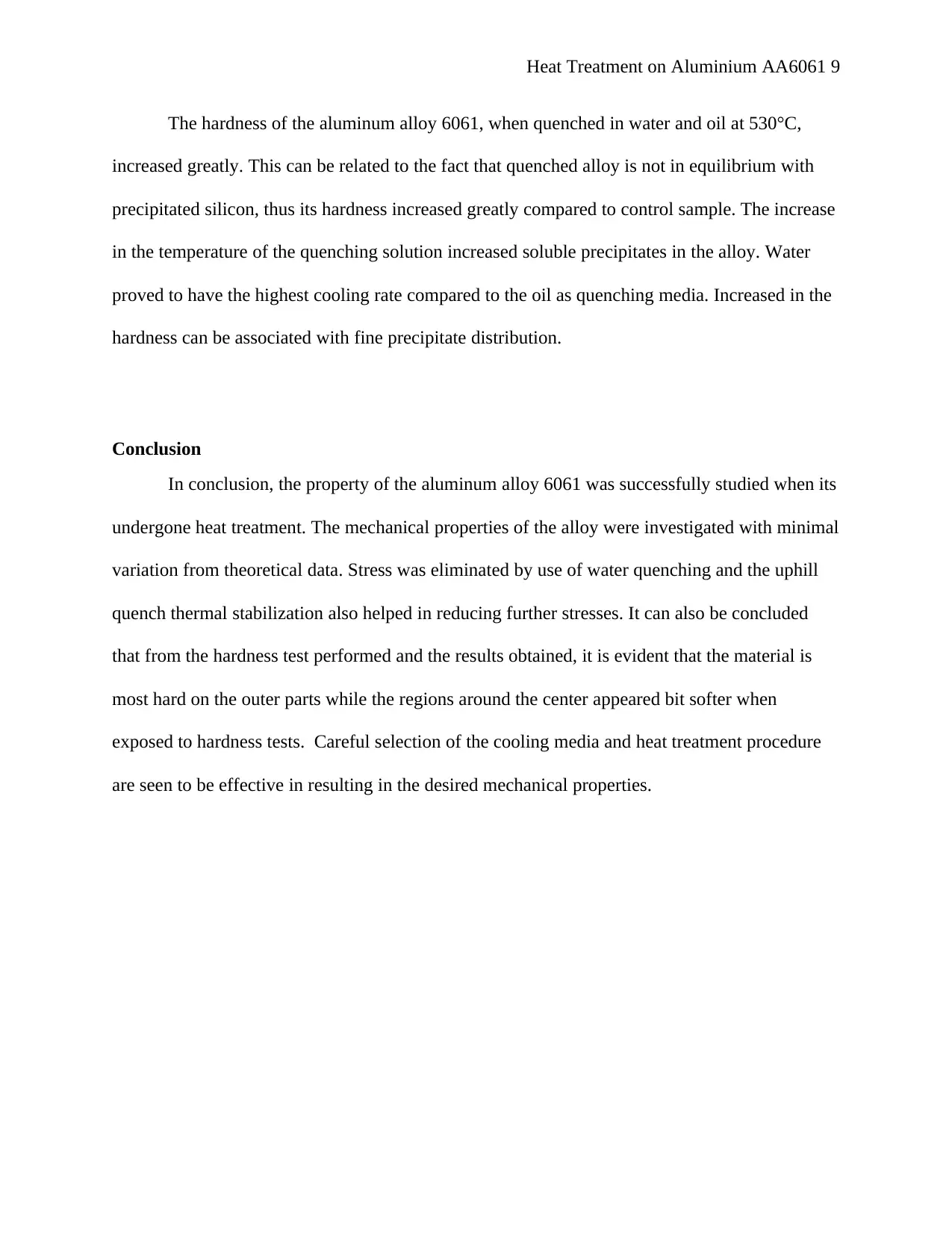
Heat Treatment on Aluminium AA6061 9
The hardness of the aluminum alloy 6061, when quenched in water and oil at 530°C,
increased greatly. This can be related to the fact that quenched alloy is not in equilibrium with
precipitated silicon, thus its hardness increased greatly compared to control sample. The increase
in the temperature of the quenching solution increased soluble precipitates in the alloy. Water
proved to have the highest cooling rate compared to the oil as quenching media. Increased in the
hardness can be associated with fine precipitate distribution.
Conclusion
In conclusion, the property of the aluminum alloy 6061 was successfully studied when its
undergone heat treatment. The mechanical properties of the alloy were investigated with minimal
variation from theoretical data. Stress was eliminated by use of water quenching and the uphill
quench thermal stabilization also helped in reducing further stresses. It can also be concluded
that from the hardness test performed and the results obtained, it is evident that the material is
most hard on the outer parts while the regions around the center appeared bit softer when
exposed to hardness tests. Careful selection of the cooling media and heat treatment procedure
are seen to be effective in resulting in the desired mechanical properties.
The hardness of the aluminum alloy 6061, when quenched in water and oil at 530°C,
increased greatly. This can be related to the fact that quenched alloy is not in equilibrium with
precipitated silicon, thus its hardness increased greatly compared to control sample. The increase
in the temperature of the quenching solution increased soluble precipitates in the alloy. Water
proved to have the highest cooling rate compared to the oil as quenching media. Increased in the
hardness can be associated with fine precipitate distribution.
Conclusion
In conclusion, the property of the aluminum alloy 6061 was successfully studied when its
undergone heat treatment. The mechanical properties of the alloy were investigated with minimal
variation from theoretical data. Stress was eliminated by use of water quenching and the uphill
quench thermal stabilization also helped in reducing further stresses. It can also be concluded
that from the hardness test performed and the results obtained, it is evident that the material is
most hard on the outer parts while the regions around the center appeared bit softer when
exposed to hardness tests. Careful selection of the cooling media and heat treatment procedure
are seen to be effective in resulting in the desired mechanical properties.
⊘ This is a preview!⊘
Do you want full access?
Subscribe today to unlock all pages.

Trusted by 1+ million students worldwide
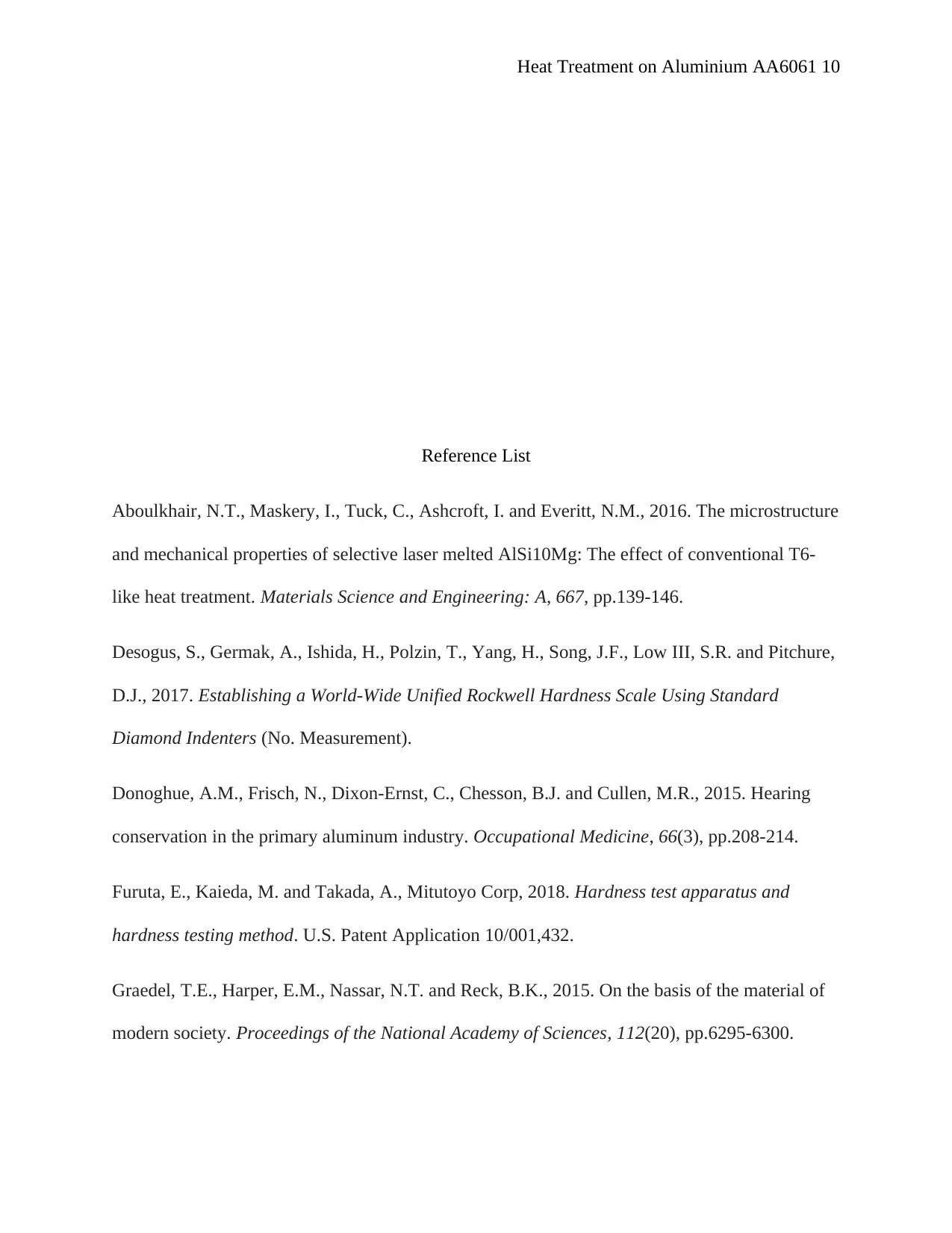
Heat Treatment on Aluminium AA6061 10
Reference List
Aboulkhair, N.T., Maskery, I., Tuck, C., Ashcroft, I. and Everitt, N.M., 2016. The microstructure
and mechanical properties of selective laser melted AlSi10Mg: The effect of conventional T6-
like heat treatment. Materials Science and Engineering: A, 667, pp.139-146.
Desogus, S., Germak, A., Ishida, H., Polzin, T., Yang, H., Song, J.F., Low III, S.R. and Pitchure,
D.J., 2017. Establishing a World-Wide Unified Rockwell Hardness Scale Using Standard
Diamond Indenters (No. Measurement).
Donoghue, A.M., Frisch, N., Dixon-Ernst, C., Chesson, B.J. and Cullen, M.R., 2015. Hearing
conservation in the primary aluminum industry. Occupational Medicine, 66(3), pp.208-214.
Furuta, E., Kaieda, M. and Takada, A., Mitutoyo Corp, 2018. Hardness test apparatus and
hardness testing method. U.S. Patent Application 10/001,432.
Graedel, T.E., Harper, E.M., Nassar, N.T. and Reck, B.K., 2015. On the basis of the material of
modern society. Proceedings of the National Academy of Sciences, 112(20), pp.6295-6300.
Reference List
Aboulkhair, N.T., Maskery, I., Tuck, C., Ashcroft, I. and Everitt, N.M., 2016. The microstructure
and mechanical properties of selective laser melted AlSi10Mg: The effect of conventional T6-
like heat treatment. Materials Science and Engineering: A, 667, pp.139-146.
Desogus, S., Germak, A., Ishida, H., Polzin, T., Yang, H., Song, J.F., Low III, S.R. and Pitchure,
D.J., 2017. Establishing a World-Wide Unified Rockwell Hardness Scale Using Standard
Diamond Indenters (No. Measurement).
Donoghue, A.M., Frisch, N., Dixon-Ernst, C., Chesson, B.J. and Cullen, M.R., 2015. Hearing
conservation in the primary aluminum industry. Occupational Medicine, 66(3), pp.208-214.
Furuta, E., Kaieda, M. and Takada, A., Mitutoyo Corp, 2018. Hardness test apparatus and
hardness testing method. U.S. Patent Application 10/001,432.
Graedel, T.E., Harper, E.M., Nassar, N.T. and Reck, B.K., 2015. On the basis of the material of
modern society. Proceedings of the National Academy of Sciences, 112(20), pp.6295-6300.
Paraphrase This Document
Need a fresh take? Get an instant paraphrase of this document with our AI Paraphraser
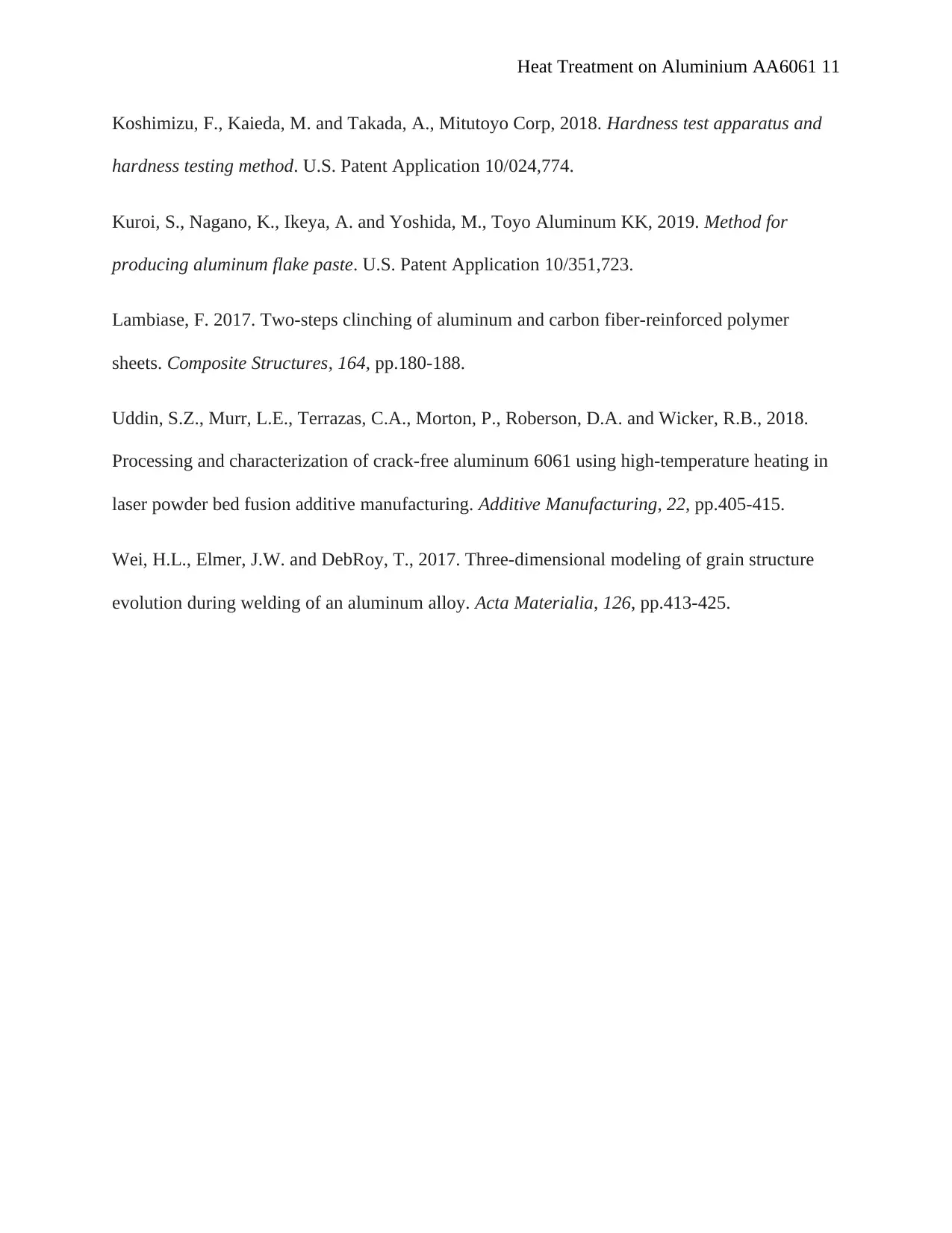
Heat Treatment on Aluminium AA6061 11
Koshimizu, F., Kaieda, M. and Takada, A., Mitutoyo Corp, 2018. Hardness test apparatus and
hardness testing method. U.S. Patent Application 10/024,774.
Kuroi, S., Nagano, K., Ikeya, A. and Yoshida, M., Toyo Aluminum KK, 2019. Method for
producing aluminum flake paste. U.S. Patent Application 10/351,723.
Lambiase, F. 2017. Two-steps clinching of aluminum and carbon fiber-reinforced polymer
sheets. Composite Structures, 164, pp.180-188.
Uddin, S.Z., Murr, L.E., Terrazas, C.A., Morton, P., Roberson, D.A. and Wicker, R.B., 2018.
Processing and characterization of crack-free aluminum 6061 using high-temperature heating in
laser powder bed fusion additive manufacturing. Additive Manufacturing, 22, pp.405-415.
Wei, H.L., Elmer, J.W. and DebRoy, T., 2017. Three-dimensional modeling of grain structure
evolution during welding of an aluminum alloy. Acta Materialia, 126, pp.413-425.
Koshimizu, F., Kaieda, M. and Takada, A., Mitutoyo Corp, 2018. Hardness test apparatus and
hardness testing method. U.S. Patent Application 10/024,774.
Kuroi, S., Nagano, K., Ikeya, A. and Yoshida, M., Toyo Aluminum KK, 2019. Method for
producing aluminum flake paste. U.S. Patent Application 10/351,723.
Lambiase, F. 2017. Two-steps clinching of aluminum and carbon fiber-reinforced polymer
sheets. Composite Structures, 164, pp.180-188.
Uddin, S.Z., Murr, L.E., Terrazas, C.A., Morton, P., Roberson, D.A. and Wicker, R.B., 2018.
Processing and characterization of crack-free aluminum 6061 using high-temperature heating in
laser powder bed fusion additive manufacturing. Additive Manufacturing, 22, pp.405-415.
Wei, H.L., Elmer, J.W. and DebRoy, T., 2017. Three-dimensional modeling of grain structure
evolution during welding of an aluminum alloy. Acta Materialia, 126, pp.413-425.
1 out of 11
Your All-in-One AI-Powered Toolkit for Academic Success.
+13062052269
info@desklib.com
Available 24*7 on WhatsApp / Email
![[object Object]](/_next/static/media/star-bottom.7253800d.svg)
Unlock your academic potential
Copyright © 2020–2025 A2Z Services. All Rights Reserved. Developed and managed by ZUCOL.


